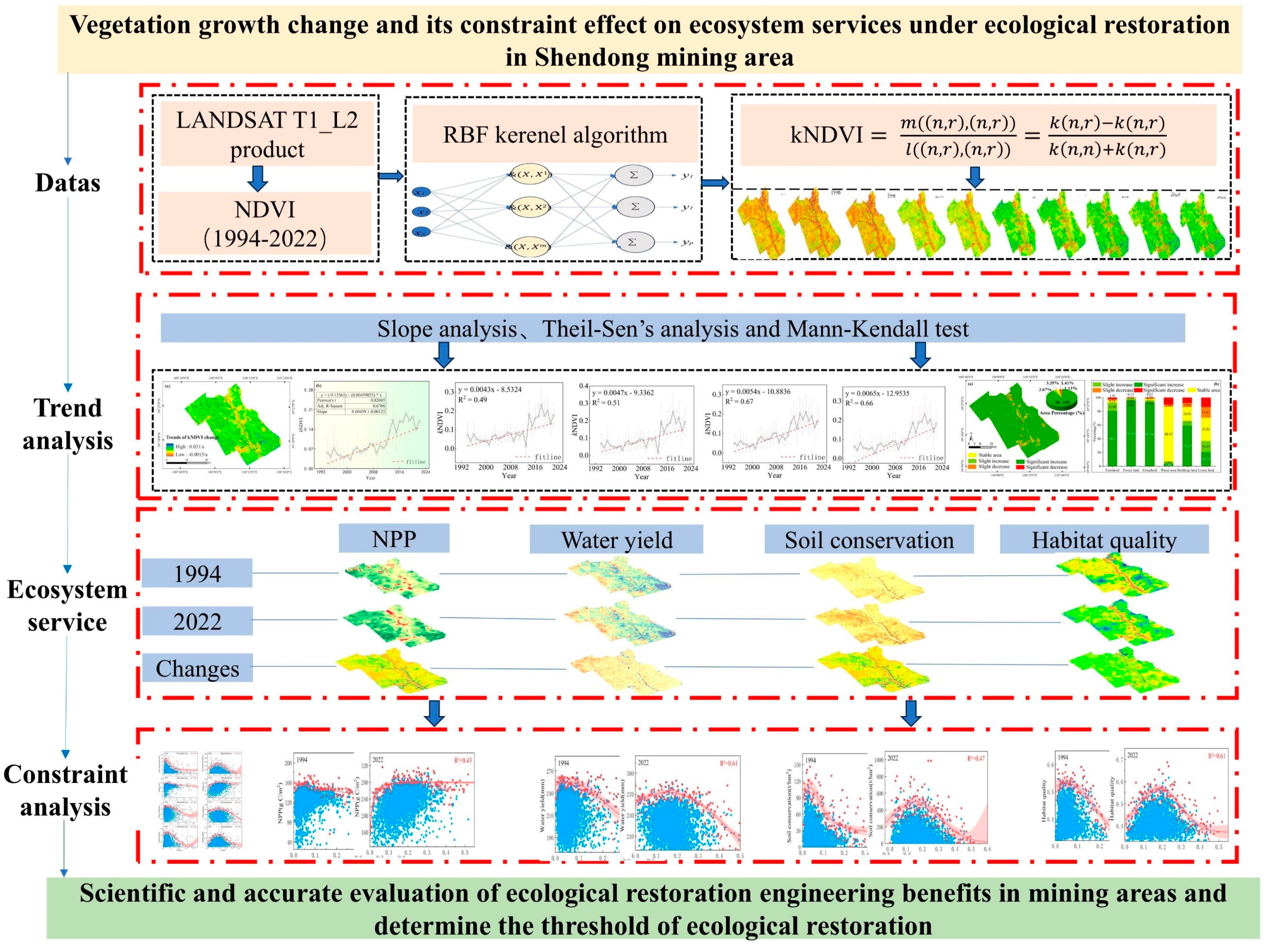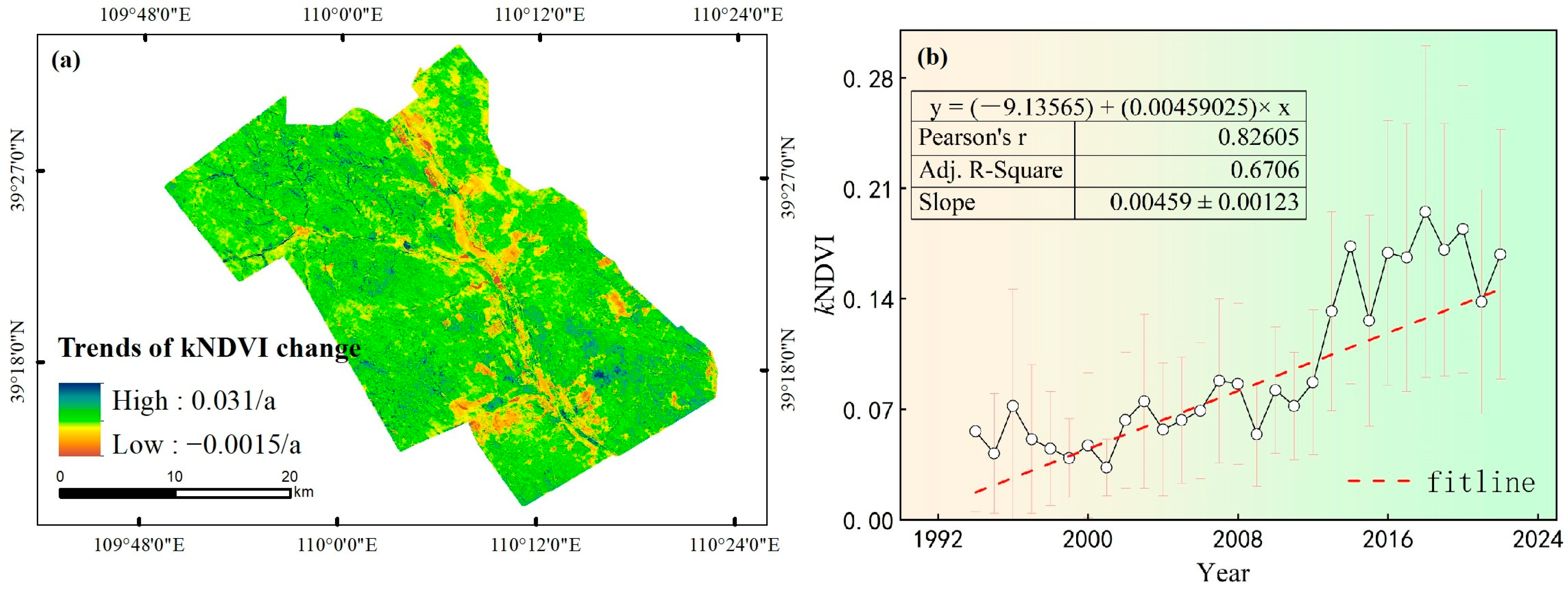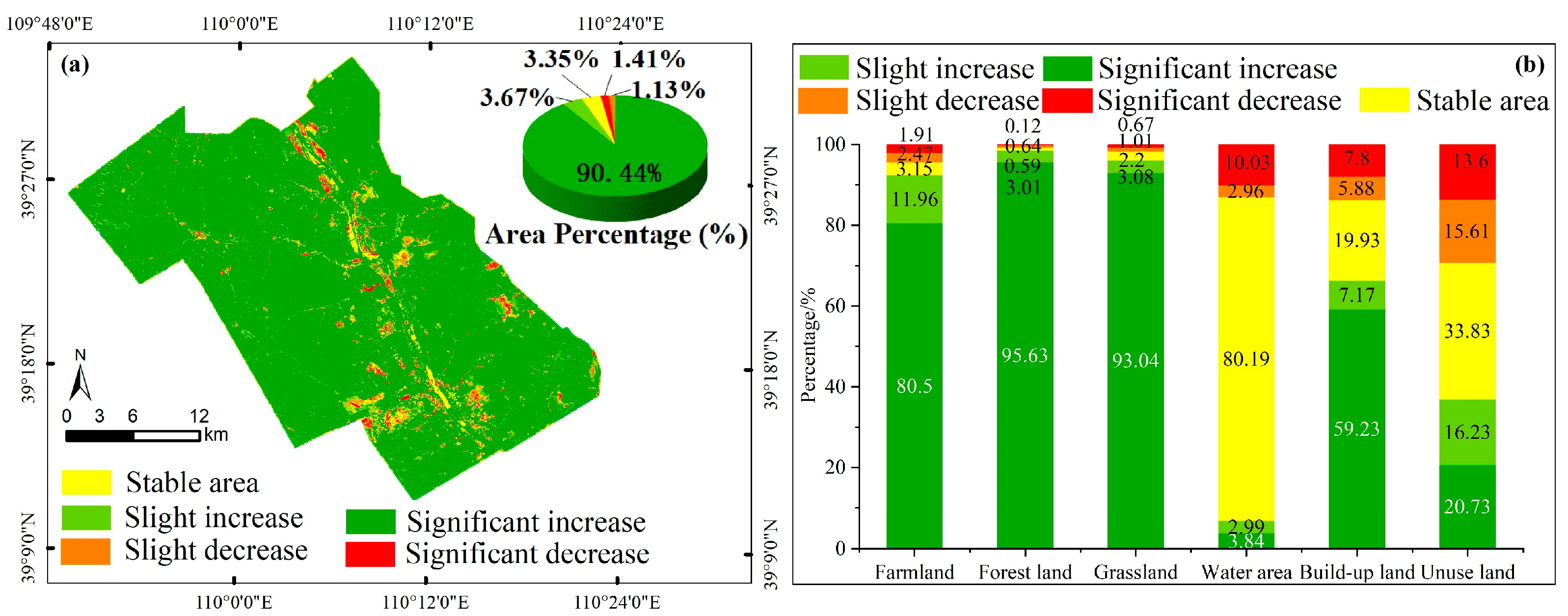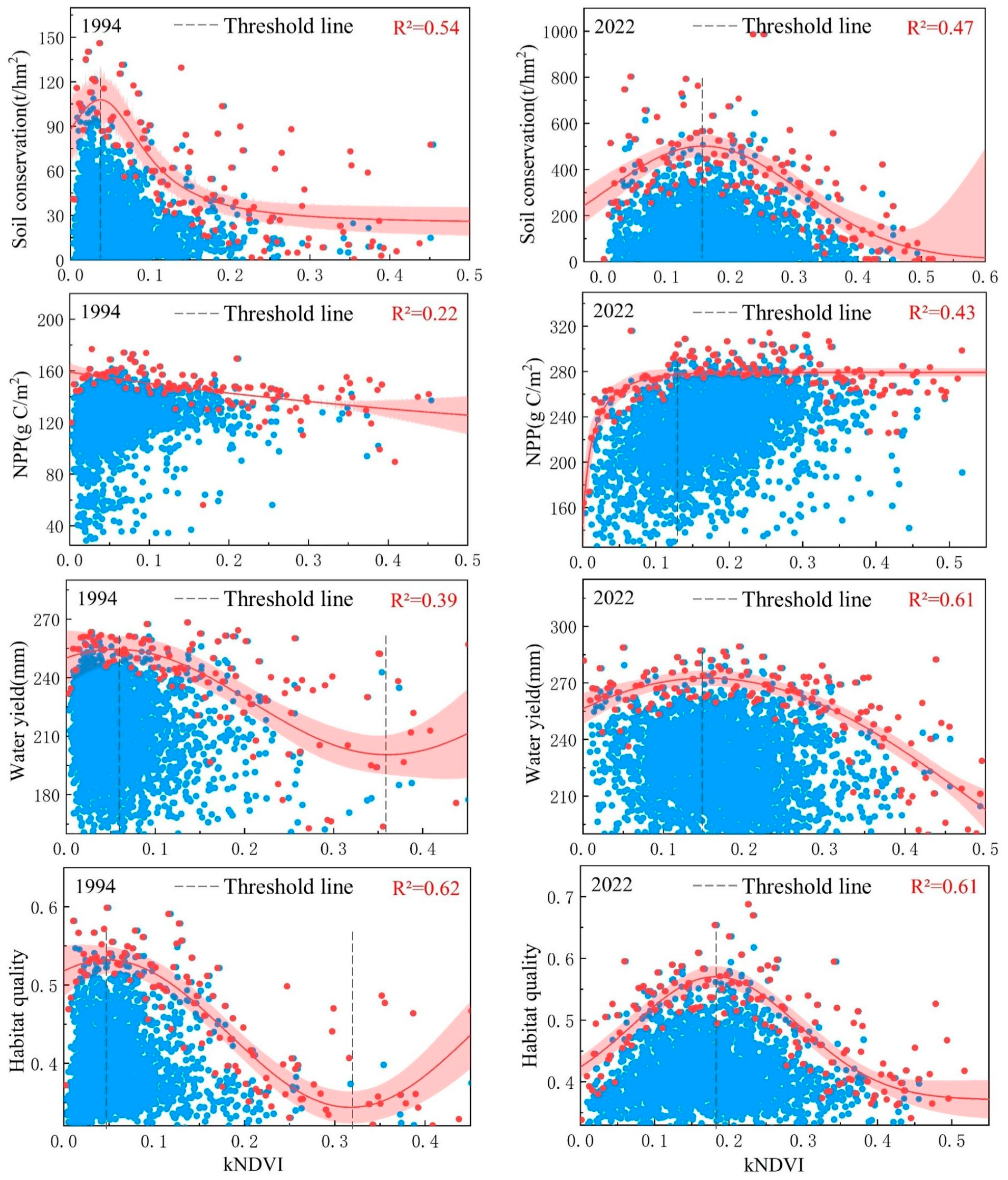Vegetation Growth Changes and Their Constraining Effects on Ecosystem Services Under Ecological Restoration in the Shendong Mining Area
Abstract
1. Introduction
2. Materials and Methods
2.1. Study Area
2.2. Data Sources
2.3. Methods
2.3.1. kNDVI Calculation
2.3.2. Variation Trends Analysis
2.3.3. Ecosystem Services Assessment
2.3.4. Definition and Extraction of Constraint Lines
3. Results
3.1. Vegetation Growth Distribution and Spatiotemporal Dynamics
3.1.1. Vegetation Growth Dynamics Temporal Variation
3.1.2. Spatial Distribution of Vegetation Growth Dynamics
3.2. Changes in Ecosystem Service Functions Under Ecological Restoration Projects
3.2.1. Variations in Individual Ecosystem Service Functions
3.2.2. Changes in Total Ecosystem Services
3.3. Constraining Effect of Vegetation Growth Change on Ecosystem Service Function
3.3.1. Individual Ecosystem Service Function Constraint by Vegetation Growth Change
3.3.2. Constraining Effect of Vegetation Growth Change on Total Ecosystem Services
4. Discussion
4.1. Vegetation Growth and Construction of Constraint Lines in Shendong Mining Area
4.2. Constraint Mechanism Between Ecosystem Services
4.3. The Internal Mechanism of Vegetation Growth Change Constraining Ecosystem Service Function
4.4. Limitation and Prospect
5. Conclusions
- (1)
- Under the influence of ecological restoration projects, kNDVI showed a fluctuating upward trend in the last 29 years, with an increase rate of 0.0046/a. In most parts of the mining area (90.44%), the vegetation growth kNDVI was significantly increased, with forest land, grassland, and cultivated land showing the largest increases. At the same time, due to the influence of human activities, the areas with poor vegetation growth mainly appeared on the edge of towns and mining areas.
- (2)
- Since the implementation of the ecological restoration project in the Shendong mining area, all ecosystem service functions in the mining area have been significantly improved. The soil conservation service, NPP function, and water production service exhibit the most significant potential for enhancement, each above 92%. The ecological restoration of the mining area greatly promoted the improvement of total ecosystem services.
- (3)
- The restoration of vegetation has improved various ecosystem service functions in the Shendong mining area. Especially after the implementation of the ecological restoration project, the restriction of vegetation growth kNDVI on ecosystem services began to weaken. In 2022, the threshold of vegetation growth kNDVI for the maximum benefit of various ecosystem services should be between 0.1 and 0.2. The kNDVI threshold for the maximum benefit of total ecosystem services is 0.225.
- (4)
- Ecological restoration has increased the vegetation coverage rate in the mining area, and the increase in vegetation coverage has significantly enhanced the ecosystem service function. Ecological restoration projects, changes in vegetation coverage, and ecosystem services form a close and mutually reinforcing connection. Further explanation of the constraining effect of vegetation coverage kNDVI on various ecosystem services and its changes can serve as an important reference for future vegetation restoration, especially the constraining thresholds for various ecosystem services, which can be an important basis for future ecological regulation.
Author Contributions
Funding
Data Availability Statement
Acknowledgments
Conflicts of Interest
References
- Bogdanov, D.; Ram, M.; Aghahosseini, A.; Gulagi, A.; Oyewo, A.S.; Child, M.; Caldera, U.; Sadovskaia, K.; Farfan, J.; De Souza Noel Simas Barbosa, L.; et al. Low-cost renewable electricity as the key driver of the global energy transition towards sustainability. Energy 2021, 227, 120467. [Google Scholar] [CrossRef]
- Xu, Y.; Li, J.; Zhang, C.; Raval, S.; Guo, L.; Yang, F. Dynamics of carbon sequestration in vegetation affected by large-scale surface coal mining and subsequent restoration. Sci. Rep. 2024, 14, 13479. [Google Scholar] [CrossRef] [PubMed]
- Li, Y.; Cen, H.; Lin, T.-Y.; Lin, Y.-N.; Chiu, Y.-H. Sustainable coal mine and coal land development in China. Resour. Policy 2022, 79, 103092. [Google Scholar] [CrossRef]
- Feng, Y.; Wang, J.; Bai, Z.; Reading, L. Effects of surface coal mining and land reclamation on soil properties: A review. Earth-Sci. Rev. 2019, 191, 12–25. [Google Scholar] [CrossRef]
- Jakob, M.; Steckel, J.C.; Jotzo, F.; Sovacool, B.K.; Cornelsen, L.; Chandra, R.; Edenhofer, O.; Holden, C.; Löschel, A.; Nace, T.; et al. The future of coal in a carbon-constrained climate. Nat. Clim. Change 2020, 10, 704–707. [Google Scholar] [CrossRef]
- Liu, X.; Zeng, Y.; Wu, Q.; Meng, S.; Liang, J.; Hou, Z. Ecological-Based Mining: A Coal–Water–Thermal Collaborative Paradigm in Ecologically Fragile Areas in Western China. Engineering 2024, 38, 209–222. [Google Scholar] [CrossRef]
- Yang, S.; Gao, X. Application of environmental protection investment benefit model of coal enterprises in environmental protection construction of smart city. Heliyon 2023, 9, e19025. [Google Scholar] [CrossRef]
- Jiang, H.; Fan, G.; Zhang, D.; Zhang, S.; Fan, Y. Evaluation of eco-environmental quality for the coal-mining region using multi-source data. Sci. Rep. 2022, 12, 6623. [Google Scholar] [CrossRef]
- Zhao, L.-T.; Liu, Z.-T.; Cheng, L. How will China’s coal industry develop in the future? A quantitative analysis with policy implications. Energy 2021, 235, 121406. [Google Scholar] [CrossRef]
- Zhang, Z.; Tong, Z.; Zhang, L.; Liu, Y. What are the dominant factors and optimal driving threshold for the synergy and tradeoff between ecosystem services, from a nonlinear coupling perspective? J. Clean. Prod. 2023, 422, 138609. [Google Scholar] [CrossRef]
- Hong, G.; Liu, S.; Liu, W.; Wu, X. Nonlinear trade-off relationship and critical threshold between ecosystem services and climate resilience for sustainable urban development. Sustain. Cities Soc. 2024, 103, 105253. [Google Scholar] [CrossRef]
- Chen, Y.-P.; Wang, K.-B.; Fu, B.-J.; Wang, Y.-F.; Tian, H.-W.; Wang, Y.; Zhang, Y. 65% cover is the sustainable vegetation threshold on the Loess Plateau. Environ. Sci. Ecotechnol. 2024, 22, 100442. [Google Scholar] [CrossRef]
- Zhang, X.; Song, J.; Wang, Y.; Sun, H.; Li, Q. Threshold effects of vegetation coverage on runoff and soil loss in the Loess Plateau of China: A meta-analysis. Geoderma 2022, 412, 115720. [Google Scholar] [CrossRef]
- Li, W.; Chen, J.; Zhang, Z. Forest quality-based assessment of the Returning Farmland to Forest Program at the community level in SW China. For. Ecol. Manag. 2020, 461, 117938. [Google Scholar] [CrossRef]
- Wang, Q.; Liu, H.; Liang, B.; Shi, L.; Wu, L.; Cao, J. Will large-scale forestation lead to a soil water deficit crisis in China’s drylands? Sci. Bull. 2024, 69, 1506–1514. [Google Scholar] [CrossRef] [PubMed]
- Boldy, R.; Santini, T.; Annandale, M.; Erskine, P.D.; Sonter, L.J. Understanding the impacts of mining on ecosystem services through a systematic review. Extr. Ind. Soc. 2021, 8, 457–466. [Google Scholar] [CrossRef]
- Zhou, G.; Eisenhauer, N.; Terrer, C.; Eldridge, D.J.; Duan, H.; Guirado, E.; Berdugo, M.; Zhou, L.; Liu, S.; Zhou, X.; et al. Resistance of ecosystem services to global change weakened by increasing number of environmental stressors. Nat. Geosci. 2024, 17, 882–888. [Google Scholar] [CrossRef]
- Zhang, Z.; Li, G.; Su, X.; Zhuang, X.; Wang, L.; Fu, H.; Li, L. Geochemical controls on the enrichment of fluoride in the mine water of the Shendong mining area, China. Chemosphere 2021, 284, 131388. [Google Scholar] [CrossRef]
- Tianjiao, F.; Tianxing, W.; Keesstra, S.D.; Jianjun, Z.; Huaxing, B.; Ruoshui, W.; Ping, W. Long-term effects of vegetation restoration on hydrological regulation functions and the implications to afforestation on the Loess Plateau. Agric. For. Meteorol. 2023, 330, 109313. [Google Scholar] [CrossRef]
- Zheng, W.; Guo, X.; Zhou, P.; Tang, L.; Lai, J.; Dai, Y.; Yan, W.; Wu, J. Vegetation restoration enhancing soil carbon sequestration in karst rocky desertification ecosystems: A meta-analysis. J. Environ. Manag. 2024, 370, 122530. [Google Scholar] [CrossRef]
- Ma, T.; Wang, T.; Yang, D.; Yang, S. Impacts of vegetation restoration on water resources and carbon sequestration in the mountainous area of Haihe River basin, China. Sci. Total Environ. 2023, 869, 161724. [Google Scholar] [CrossRef] [PubMed]
- Wang, Z.; Fu, B.; Wu, X.; Li, Y.; Feng, Y.; Wang, S.; Wei, F.; Zhang, L. Vegetation resilience does not increase consistently with greening in China’s Loess Plateau. Commun. Earth Environ. 2023, 4, 336. [Google Scholar] [CrossRef]
- Liu, J.; Dou, Y.; Chen, H. Stepwise Ecological Restoration: A framework for improving restoration outcomes. Geogr. Sustain. 2024, 5, 160–166. [Google Scholar] [CrossRef]
- Zhang, Z.; Liu, Y.; Wang, Y.; Liu, Y.; Zhang, Y.; Zhang, Y. What factors affect the synergy and tradeoff between ecosystem services, and how, from a geospatial perspective? J. Clean. Prod. 2020, 257, 120454. [Google Scholar] [CrossRef]
- Chang, B.; Chen, B.; Chen, W.; Xu, S.; He, X.; Yao, J.; Huang, Y. Analysis of trade-off and synergy of ecosystem services and driving forces in urban agglomerations in Northern China. Ecol. Indic. 2024, 165, 112210. [Google Scholar] [CrossRef]
- Feng, Z.; Jin, X.; Chen, T.; Wu, J. Understanding trade-offs and synergies of ecosystem services to support the decision-making in the Beijing–Tianjin–Hebei region. Land Use Policy 2021, 106, 105446. [Google Scholar] [CrossRef]
- Liu, Y.; Zhang, C.; Zeng, H. Constraint effects among several key ecosystem service types and their influencing factors: A case study of the Pearl River Delta, China. Ecol. Indic. 2023, 146, 109883. [Google Scholar] [CrossRef]
- Zhao, Z.; Dai, E. Vegetation cover dynamics and its constraint effect on ecosystem services on the Qinghai-Tibet Plateau under ecological restoration projects. J. Environ. Manag. 2024, 356, 120535. [Google Scholar] [CrossRef]
- He, J.; Li, Y.; Shi, X.; Hou, H. Integrating the impacts of vegetation coverage on ecosystem services to determine ecological restoration targets for adaptive management on the Loess Plateau, China. Land Degrad. Dev. 2023, 34, 5697–5712. [Google Scholar] [CrossRef]
- de la Barrera, F.; Rubio, P.; Banzhaf, E. The value of vegetation cover for ecosystem services in the suburban context. Urban For. Urban Green. 2016, 16, 110–122. [Google Scholar] [CrossRef]
- Li, B.V.; Wu, S.; Hua, F.; Mi, X. The past and future of ecosystem restoration in China. Curr. Biol. 2024, 34, R379–R387. [Google Scholar] [CrossRef]
- Liu, Y.; Wei, J.; Bi, Y.; Yue, H.; He, X. Evaluation of ecosystem service function in Shendong mining area. Meitan Xuebao/J. China Coal Soc. 2021, 46, 1599–1613. [Google Scholar] [CrossRef]
- Wang, X.; Peng, S.; He, Y. Soil moisture evidence of self-restoration in coal mining subsidence area of Shendong Mining area: Cognition based on stable isotopes. Sci. Total Environ. 2024, 951, 175831. [Google Scholar] [CrossRef] [PubMed]
- Wang, Q.; Moreno-Martínez, Á.; Muñoz-Marí, J.; Campos-Taberner, M.; Camps-Valls, G. Estimation of vegetation traits with kernel NDVI. ISPRS J. Photogramm. Remote Sens. 2023, 195, 408–417. [Google Scholar] [CrossRef]
- Zeng, Y.; Hao, D.; Huete, A.; Dechant, B.; Berry, J.; Chen, J.M.; Joiner, J.; Frankenberg, C.; Bond-Lamberty, B.; Ryu, Y.; et al. Optical vegetation indices for monitoring terrestrial ecosystems globally. Nat. Rev. Earth Environ. 2022, 3, 477–493. [Google Scholar] [CrossRef]
- Guo, Y.; Huang, Y.; Li, J.; Ouyang, S.; Wu, L.; Qi, W. Study on the influence of mining disturbance on the variation characteristics of vegetation index: A case study of Lingwu Mining Area. Environ. Dev. 2023, 45, 100811. [Google Scholar] [CrossRef]
- Jiang, W.; Yuan, L.; Wang, W.; Cao, R.; Zhang, Y.; Shen, W. Spatio-temporal analysis of vegetation variation in the Yellow River Basin. Ecol. Indic. 2015, 51, 117–126. [Google Scholar] [CrossRef]
- Hamed, K.H. Trend detection in hydrologic data: The Mann–Kendall trend test under the scaling hypothesis. J. Hydrol. 2008, 349, 350–363. [Google Scholar] [CrossRef]
- Zhang, Y.; Hu, Q.; Zou, F. Spatio-Temporal Changes of Vegetation Net Primary Productivity and Its Driving Factors on the Qinghai-Tibetan Plateau from 2001 to 2017. Remote Sens. 2021, 13, 1566. [Google Scholar] [CrossRef]
- Zhu, W.-q.; Pan, Y.-z.; Liu, X.; Wang, A.-l. Spatio-temporal distribution of net primary productivity along the Northeast China Transect and its response to climatic change. J. For. Res. 2006, 17, 93–98. [Google Scholar] [CrossRef]
- Costanza, R.; d’Arge, R.; de Groot, R.; Farber, S.; Grasso, M.; Hannon, B.; Limburg, K.; Naeem, S.; O’Neill, R.V.; Paruelo, J.; et al. The value of the world’s ecosystem services and natural capital. Nature 1997, 387, 253–260. [Google Scholar] [CrossRef]
- Bai, Y.; Zheng, H.; Ouyang, Z.; Zhuang, C.; Jiang, B. Modeling hydrological ecosystem services and tradeoffs: A case study in Baiyangdian watershed, China. Environ. Earth Sci. 2013, 70, 709–718. [Google Scholar] [CrossRef]
- Lal, R. Soil conservation and ecosystem services. Int. Soil Water Conserv. Res. 2014, 2, 36–47. [Google Scholar] [CrossRef]
- Jamshidi, R.; Dragovich, D.; Webb, A.A. Distributed empirical algorithms to estimate catchment scale sediment connectivity and yield in a subtropical region. Hydrol. Process. 2014, 28, 2671–2684. [Google Scholar] [CrossRef]
- Yuan, W.; Chen, L.; Chen, H.; Deng, S.; Ji, H.; Liang, F. Assessing habitat quality at Poyang Lake based on InVEST and Geodetector modeling. Ecol. Evol. 2023, 13, e10759. [Google Scholar] [CrossRef]
- Tang, F.; Fu, M.; Wang, L.; Zhang, P. Land-use change in Changli County, China: Predicting its spatio-temporal evolution in habitat quality. Ecol. Indic. 2020, 117, 106719. [Google Scholar] [CrossRef]
- An, Q.; Yuan, X.; Zhang, X.; Yang, Y.; Chen, J.; An, J. Spatio-temporal interaction and constraint effects between ecosystem services and human activity intensity in Shaanxi Province, China. Ecol. Indic. 2024, 160, 111937. [Google Scholar] [CrossRef]
- Gao, Y.; Fu, S.; Cui, H.; Cao, Q.; Wang, Z.; Zhang, Z.; Wu, Q.; Qiao, J. Identifying the spatio-temporal pattern of drought characteristics and its constraint factors in the Yellow River Basin. Ecol. Indic. 2023, 154, 110753. [Google Scholar] [CrossRef]
- Zhang, L.; Ming, D.; Li, Y.; Cai, J.; Zhang, Z. A new slope unit extraction method based on terrain topology searching and vector similarity constraint for landslide analysis. CATENA 2024, 246, 108355. [Google Scholar] [CrossRef]
- Li, Z.; Guan, D.; Zhou, L.; Zhang, Y. Constraint relationship of ecosystem services in the Yangtze River Economic Belt, China. Environ. Sci. Pollut. Res. 2022, 29, 12484–12505. [Google Scholar] [CrossRef] [PubMed]
- Mills, A.; Fey, M.V.; Gröngröft, A.; Petersen, A.; Medinski, T. Unravelling the effects of soil properties on water infiltration: Segmented quantile regression on a large data set from arid south-west Africa. Aust. J. Soil Res. 2006, 44, 783–797. [Google Scholar] [CrossRef]
- Li, X.; Ma, L.; Ruman, A.M.; Iqbal, N.; Strielkowski, W. Impact of natural resource mining on sustainable economic development: The role of education and green innovation in China. Geosci. Front. 2024, 15, 101703. [Google Scholar] [CrossRef]
- Zhang, X.; Zhichao, C.; Jiao, Y.; Cheng, Y.; Zhu, Z.; Wang, S.; Zhang, H. Quantitative Analysis of Vegetation Dynamics and Driving Factors in the Shendong Mining Area under the Background of Coal Mining. Forests 2024, 15, 1207. [Google Scholar] [CrossRef]
- Sha, Z.; Bai, Y.; Li, R.; Lan, H.; Zhang, X.; Li, J.; Liu, X.; Chang, S.; Xie, Y. The global carbon sink potential of terrestrial vegetation can be increased substantially by optimal land management. Commun. Earth Environ. 2022, 3, 8. [Google Scholar] [CrossRef]
- Feng, H.; Kang, P.; Deng, Z.; Zhao, W.; Hua, M.; Zhu, X.; Wang, Z. The impact of climate change and human activities to vegetation carbon sequestration variation in Sichuan and Chongqing. Environ. Res. 2023, 238, 117138. [Google Scholar] [CrossRef]
- Yang, X.; Yao, W.; Li, P.; Hu, J.; Latifi, H.; Kang, L.; Wang, N.; Zhang, D. Changes of SOC Content in China’s Shendong Coal Mining Area during 1990–2020 Investigated Using Remote Sensing Techniques. Sustainability 2022, 14, 7374. [Google Scholar] [CrossRef]
- Zhang, L.; Yang, L.; Zohner, C.M.; Crowther, T.W.; Li, M.; Shen, F.; Guo, M.; Qin, J.; Yao, L.; Zhou, C. Direct and indirect impacts of urbanization on vegetation growth across the world’s cities. Sci. Adv. 2022, 8, eabo0095. [Google Scholar] [CrossRef]
- Li, Y.; Zheng, Z.; Qin, Y.; Rong, P. Relative contributions of natural and man-made factors to vegetation cover change of environmentally sensitive and vulnerable areas of China. J. Clean. Prod. 2021, 321, 128917. [Google Scholar] [CrossRef]
- Zhou, W.; Head, M.J.; Deng, L. Climate changes in northern China since the late Pleistocene and its response to global change. Quat. Int. 2001, 83–85, 285–292. [Google Scholar] [CrossRef]
- Wang, X.; Li, Y.; Yan, M.; Gong, X. Changes in temperature and precipitation extremes in the arid regions of China during 1960–2016. Front. Ecol. Evol. 2022, 10, 902813. [Google Scholar] [CrossRef]
- Duo, A.; Zhao, W.; Qu, X.; Jing, R.; Xiong, K. Spatio-temporal variation of vegetation coverage and its response to climate change in North China plain in the last 33 years. Int. J. Appl. Earth Obs. Geoinf. 2016, 53, 103–117. [Google Scholar] [CrossRef]
- Fu, B.; Wang, S.; Su, C.; Forsius, M. Linking ecosystem processes and ecosystem services. Curr. Opin. Environ. Sustain. 2013, 5, 4–10. [Google Scholar] [CrossRef]
- Wang, J.; Wu, W.; Yang, M.; Gao, Y.; Shao, J.; Yang, W.; Ma, G.; Yu, F.; Yao, N.; Jiang, H. Exploring the complex trade-offs and synergies of global ecosystem services. Environ. Sci. Ecotechnol. 2024, 21, 100391. [Google Scholar] [CrossRef] [PubMed]
- Li, S.; Li, X.; Dou, H.; Dang, D.; Gong, J. Integrating constraint effects among ecosystem services and drivers on seasonal scales into management practices. Ecol. Indic. 2021, 125, 107425. [Google Scholar] [CrossRef]
- He, S.; Xie, Y.; Zhang, J.; Luo, Y.; Wang, Q. Heterogeneity of Ecosystem Service Interactions Through Scale Effects and Time Effects and Their Social-Ecological Determinants in the Tuo River Basin. Land 2025, 14, 103. [Google Scholar] [CrossRef]
- Xu, Z.; Peng, J. Recognizing ecosystem service’s contribution to SDGs: Ecological foundation of sustainable development. Geogr. Sustain. 2024, 5, 511–525. [Google Scholar] [CrossRef]
- Ouyang, Z.; Zheng, H.; Xiao, Y.; Polasky, S.; Liu, J.; Xu, W.; Wang, Q.; Zhang, L.; Xiao, Y.; Rao, E.; et al. Improvements in ecosystem services from investments in natural capital. Science 2016, 352, 1455–1459. [Google Scholar] [CrossRef]
- Matson, P.A.; Parton, W.J.; Power, A.G.; Swift, M.J. Agricultural Intensification and Ecosystem Properties. Science 1997, 277, 504–509. [Google Scholar] [CrossRef]
- Wang, H.; Wang, L.; Yang, Q.; Fu, X.; Guo, M.; Zhang, S.; Wu, D.; Zhu, Y.; Wu, G. Interaction between ecosystem service supply and urbanization in northern China. Ecol. Indic. 2023, 147, 109923. [Google Scholar] [CrossRef]
- Yuan, Y.; Wu, S.; Yu, Y.; Tong, G.; Mo, L.; Yan, D.; Li, F. Spatiotemporal interaction between ecosystem services and urbanization: Case study of Nanjing City, China. Ecol. Indic. 2018, 95, 917–929. [Google Scholar] [CrossRef]
- Wang, X.; Xiao, X.; Xu, X.; Zou, Z.; Chen, B.; Qin, Y.; Zhang, X.; Dong, J.; Liu, D.; Pan, L.; et al. Rebound in China’s coastal wetlands following conservation and restoration. Nat. Sustain. 2021, 4, 1076–1083. [Google Scholar] [CrossRef]
- Mustafa, A.; Minggang, X.; Ali Shah, S.A.; Abrar, M.M.; Nan, S.; Baoren, W.; Zejiang, C.; Saeed, Q.; Naveed, M.; Mehmood, K.; et al. Soil aggregation and soil aggregate stability regulate organic carbon and nitrogen storage in a red soil of southern China. J. Environ. Manag. 2020, 270, 110894. [Google Scholar] [CrossRef]
- Xiong, M.; Sun, R.; Chen, L. Effects of soil conservation techniques on water erosion control: A global analysis. Sci. Total Environ. 2018, 645, 753–760. [Google Scholar] [CrossRef] [PubMed]
- Chen, Y.; Chen, L.; Cheng, Y.; Ju, W.; Chen, H.Y.H.; Ruan, H. Afforestation promotes the enhancement of forest LAI and NPP in China. For. Ecol. Manag. 2020, 462, 117990. [Google Scholar] [CrossRef]
- Hong, P.; Schmid, B.; De Laender, F.; Eisenhauer, N.; Zhang, X.; Chen, H.; Craven, D.; De Boeck, H.J.; Hautier, Y.; Petchey, O.L.; et al. Biodiversity promotes ecosystem functioning despite environmental change. Ecol. Lett. 2022, 25, 555–569. [Google Scholar] [CrossRef]
- Ou, Z.; Pang, S.; He, Q.; Peng, Y.; Huang, X.; Shen, W. Effects of vegetation restoration and environmental factors on understory vascular plants in a typical karst ecosystem in southern China. Sci. Rep. 2020, 10, 12011. [Google Scholar] [CrossRef]
- Ma, R.; Lü, Y.; Fu, B.; Lü, D.; Wu, X.; Sun, S.; Zhang, Y. A modified habitat quality model to incorporate the effects of ecological restoration. Environ. Res. Lett. 2022, 17, 104029. [Google Scholar] [CrossRef]
- Zhang, M.; Zhang, L.; He, H.; Ren, X.; Lv, Y.; Niu, Z.e.; Chang, Q.; Xu, Q.; Liu, W. Improvement of ecosystem quality in National Key Ecological Function Zones in China during 2000–2015. J. Environ. Manag. 2022, 324, 116406. [Google Scholar] [CrossRef]
- Xiao, S.; Fügener, T.; Wende, W.; Yan, W.; Chen, H.; Syrbe, R.; Xue, B. The dynamics of vegetation and implications for ecosystem services in the context of urbanisation: An example from Huangyan-Taizhou, China. Ecol. Eng. 2022, 179, 106614. [Google Scholar] [CrossRef]
- Shi, P.; Li, Z.; Li, P.; Zhang, Y.; Li, B. Trade-offs Among Ecosystem Services After Vegetation Restoration in China’s Loess Plateau. Nat. Resour. Res. 2021, 30, 2703–2713. [Google Scholar] [CrossRef]
- Sonter, L.J.; Ali, S.H.; Watson, J.E.M. Mining and biodiversity: Key issues and research needs in conservation science. Proc. R. Soc. B Biol. Sci. 2018, 285, 20181926. [Google Scholar] [CrossRef] [PubMed]
- Lèbre, É.; Corder, G.D.; Golev, A. Sustainable practices in the management of mining waste: A focus on the mineral resource. Miner. Eng. 2017, 107, 34–42. [Google Scholar] [CrossRef]
- Peng, X.; Dai, X.; Shi, R.; Zheng, Y.; Liu, X.; Xiao, Y.; Li, W.; Zhang, Y.; Wang, J.; Huang, H. Investigating the Effects of Mining on Ecosystem Services in Panzhihua City: A Multi-Scenario Analysis. Land 2024, 13, 819. [Google Scholar] [CrossRef]
- Huang, C.; Yang, Q.; Guo, Y.; Zhang, Y.; Guo, L. The pattern, change and driven factors of vegetation cover in the Qin Mountains region. Sci. Rep. 2020, 10, 20591. [Google Scholar] [CrossRef]
- Pennekamp, F.; Pontarp, M.; Tabi, A.; Altermatt, F.; Alther, R.; Choffat, Y.; Fronhofer, E.A.; Ganesanandamoorthy, P.; Garnier, A.; Griffiths, J.I.; et al. Biodiversity increases and decreases ecosystem stability. Nature 2018, 563, 109–112. [Google Scholar] [CrossRef]









| Dataset | Type | Spatial Resolution/m | Time Resolution/Year | Data Source | |
|---|---|---|---|---|---|
| Climatic data | Temperature | Raster | 1000 | 1994–2022 (monthly) | National Tibetan Plateau Data Center https//data.tpdc.ac.cn/ (accessed on 5 March 2025) |
| Precipitation | Raster | 1000 | 1994–2022 (monthly) | National Tibetan Plateau Data Center https//data.tpdc.ac.cn/ (accessed on 6 March 2025) | |
| Elevation data | DEM | Raster | 30 | 2019–2021 | China geospatial data cloud https://www.gscloud.cn/ (accessed on 12 February 2025) |
| Soil data | Soil properties | Shp/ Raster | 1000 | 1994, 2022 | Soil Science Database http://vdb3.soil.csdb.cn/ (accessed on 21 February 2025) |
| Land use data | Land use/cover | Raster | 30 | 1994, 2022 | Human-computer interaction interpretation |
| Sen’s Value | Z Value | Trend Type |
|---|---|---|
| ≥0.0005 | ≥1.96 | Significant increase |
| ≥0.0005 | −1.96–1.96 | Slight increase |
| −0.0005–0.0005 | −1.96–1.96 | Stable area |
| ≤−0.0005 | −1.96–1.96 | Slight decrease |
| ≤−0.0005 | ≤−1.96 | Significant decrease |
Disclaimer/Publisher’s Note: The statements, opinions and data contained in all publications are solely those of the individual author(s) and contributor(s) and not of MDPI and/or the editor(s). MDPI and/or the editor(s) disclaim responsibility for any injury to people or property resulting from any ideas, methods, instructions or products referred to in the content. |
© 2025 by the authors. Licensee MDPI, Basel, Switzerland. This article is an open access article distributed under the terms and conditions of the Creative Commons Attribution (CC BY) license (https://creativecommons.org/licenses/by/4.0/).
Share and Cite
Zhang, X.; Chen, Z.; Jiao, Y.; Cheng, Y.; Zhu, Z.; Wang, S.; Zhang, H. Vegetation Growth Changes and Their Constraining Effects on Ecosystem Services Under Ecological Restoration in the Shendong Mining Area. Remote Sens. 2025, 17, 1674. https://doi.org/10.3390/rs17101674
Zhang X, Chen Z, Jiao Y, Cheng Y, Zhu Z, Wang S, Zhang H. Vegetation Growth Changes and Their Constraining Effects on Ecosystem Services Under Ecological Restoration in the Shendong Mining Area. Remote Sensing. 2025; 17(10):1674. https://doi.org/10.3390/rs17101674
Chicago/Turabian StyleZhang, Xufei, Zhichao Chen, Yiheng Jiao, Yiqiang Cheng, Zhenyao Zhu, Shidong Wang, and Hebing Zhang. 2025. "Vegetation Growth Changes and Their Constraining Effects on Ecosystem Services Under Ecological Restoration in the Shendong Mining Area" Remote Sensing 17, no. 10: 1674. https://doi.org/10.3390/rs17101674
APA StyleZhang, X., Chen, Z., Jiao, Y., Cheng, Y., Zhu, Z., Wang, S., & Zhang, H. (2025). Vegetation Growth Changes and Their Constraining Effects on Ecosystem Services Under Ecological Restoration in the Shendong Mining Area. Remote Sensing, 17(10), 1674. https://doi.org/10.3390/rs17101674





